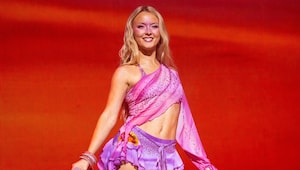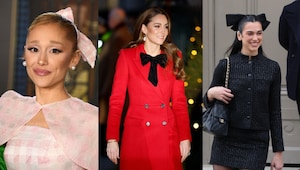Insıde the Cult of Clean Beauty
It claims to be better for your face and to stop effing up the planet, but can ‘clean beauty’ deliver on its many promises? Kate Pasola overhauls her routine for a month to find out.

Photographs: Martina Lang

“Alright, I’ll admit it, I’m a hypocrite.”
“A couple of years ago I went vegan, because opting out of animal products makes me feel healthier. And, as I’m part of a generation that’s told we’re ruining everything-—especially the planet—I also feel a responsibility to help rein in that havoc we’re collectively wreaking. So, with my Chilly’s water bottle in one hand and my bamboo fork in the other, I chomp on my lentils in the hope that it might alleviate some of the guilt I feel.
Sue me (genuinely—I have nothing to offer but my reusable-plastic coffee cup).
I’m aware how smug that paragraph sounds, okay—so it’s a perfect time to tell you about that hypocrisy I mentioned earlier. Yes, I interrogate the labels of my food for animal products and limit the plastic waste I create. But beauty-wise, it’s a different story—I’m as unnatural, synthetic and plastic-wrapped as (Donald) Trump’s monthly toupee delivery. Unfazed by gel-manicure cancer rumours/hair dye scaremongering/suggested links between eyelash curlers and
the black death (LOL, jokes), I’ve always maintained that if the EU (who are typically super-strict, cosmetically speaking) are okay with an ingredient, I am, too.
But change is in the air. The beauty industry is being shaken to its core by a movement intent on taking the toxic out of intoxicating: ‘clean beauty’. The movement is, apparently, free of ‘nasty ingredients’ and other assumed evils. The invitees? Everyone. The rules? Well, confusing as hell, it turns out.
The Cult Of Clean
It’s easy to get hooked. Ever begged Google to explain why you need sulphate-free shampoo? Dabbled in wooden toothbrushes? Considered using coconut oil on any part of your body? Then you’ve dipped a toe.
‘Free-from’ beauty has been around for over a decade, with the likes of Pai, Trilogy, Soaper Duper and Ren championing ingredient-focused, non-toxic formulations. But its descendant, clean beauty, is a difficult beast to wrestle, linked only by hundreds of companies’ different marketing strategies. There is no agreed definition, but consensus points to ‘free of undesirable ingredients’. However, ‘clean’ also calls to mind cruelty-free status, naturalness, veganism, sustainability, ethics, avoidance of ‘chemicals’ and lab synthetics—and way more besides. Those using the term often know they’re capitalising on such virtuous associations.
In 2019, the movement snowballed. Space NK, Sephora, Net-a-Porter, Cultbeauty.co.uk and Lookfantastic.com hosted entire online campaigns dedicated to terms like ‘clean’, ‘natural’ and ‘vegan’. Every brand that appears brings a new interpretation of the term clean. Take Millie Bobby Brown’s lavender-hued collection Florence By Mills. The range baits a gen-Z audience with notions of being free from not only ingredients like parabens, sulphates, dyes, animal testing and animal by-products—but also from ‘boring beauty standards’. For Jessica Alba’s company, Honest Beauty, the focus is label transparency, cleaner ingredients, education, and the use of ‘renewable resources’.
But the biggest indicator that this movement is here to stay lies in its infiltration of the luxury market.
Most trends begin at the runway and trickle down, but these days, compassion and concern are the
status symbols. When it comes to beauty, forget Miranda Priestly’s blue jumper speech in The Devil Wears Prada—this is bottom-up trend-setting.
Luxury approaches include make-up artist Gucci Westman’s ‘consciously crafted’ Westman Atelier cosmetics, and Victoria Beckham’s tortoiseshell-clad beauty collection, which launched in September 2019. Alongside lip liners, slabs of shimmery pigment and other clean cosmetics—guaranteed to be free from a list of 30+ ‘excluded ingredients’—Beckham’s range includes a £92 moisturiser (`8,000 approx), dreamed up in collaboration with world-leading stem-cell and biomedical scientist Professor Augustinus Bader. ‘Clean beauty will become the new standard, and we want to be on the right side of history,’ I’m told by VB Beauty Co-Founder Sarah Creal. ‘The clean conversation is definitely trending,’ agrees Gucci Westman. ‘But...it’s the only way in my mind to enter the cosmetic world today.’ Who am I to disobey the will of Gucci? I’ve cleaned up my diet—now it’s time to scrub up my beauty regime, too.

Cleaning Up My Act
I start by overhauling my own make-up bag and bathroom cabinet. How hard could it be?
...Very hard, it transpires. Even though I work in beauty and have access to a cornucopia of products, it leaves me exasperated. What’s better: a free-from shampoo that’s tested on animals and packaged in plastic, or one that contains some sneaky sulphates but is vegan and refillable?
I curate a make-up collection that’s as clean as possible, though the hues on offer are limited (my eyelids remain shimmering russet for the whole experience). Attempting to tame my brows with my vegan brow gel proves futile and my base, a tinted moisturiser in a passable beige, slides off by 3pm. But the worst is yet to come. I’m acne-prone, so my face needs a double-cleanse, featuring the likes of salicylic acid and niacinamide.
My new balm cleanser feels dangerously oily—I can practically feel cysts forming in real time. Following up with a ‘natural’ wash doesn’t help much—it reeks
of essential oils and leaves my face tightened like a bedsheet in the wind.
Don’t get me started on my organic, fluoride-free tooth powder, into which I prod a rapidly deteriorating bamboo toothbrush. It tastes of baking soda and coital fluids (sorry). The peppermint ‘oil-pulling mouthwash’ (which I’m supposed to keep in my mouth for 20—two-zero—minutes) also disappoints. I snap the labels and DM them to a dentist friend, who responds immediately, comparing fluoride-free tooth products to antibacterial-free handwash. Fluoride strengthens the teeth, so unless you’re allergic or an infant, it’s worth opting in if you’d rather your teeth didn’t dissolve. At this point, my will to go on has diminished even more than my tooth enamel.
I’m stressed to say the least. And stress equals cortisol, which equals wrinkles, so I enlist a £391 serum by Tata Harper (`32,000 approx). It’s 100% natural, 38% organic, vegan, cruelty-free and free from parabens, synthetics and petroleum, packaged in a recyclable glass bottle with airless dispenser pump in a 100% post-consumer paper box—surely my hot ticket to cosmetic smugdom? Truly, it’s an absolute dream to use, seeping into my skin at lightning speed. Plus, that forehead stress-line does begin to diminish with a couple of weeks of use. I cling to the hope this ‘natural’ serum could change the game.
But on closer inspection, the serum does contain ingredients like limonene (which research shows
can sensitise the skin), along with fragrance ingredients like citral and geraniol, which have been shown to be potentially allergenic, and even eugenol, which researchers believe may be cytotoxic (toxic for skin cells). Maybe I’m splitting hairs, but at £391 for a bottle (again, `34,000 approx), I expect a better effort. In its defence, all of the above are, indeed, ‘natural’ ingredients. Unfortunately, it seems ‘natural’ isn’t for me.
Also, I predict this serum to last no more than eight weeks, so that’s around £6 per day (`480 approx)—double of what I’d spend on a sandwich. ‘Who spends four hundred English pounds on skincare?’ I wonder as I drift off to sleep. Someone terrified into loose-pursed paralysis by fear of putting the wrong thing on their skin, it occurs to me. That’s who.
Getting Hands-On
Next up, nails. Usually I’d pick the longest-lasting polish, with little regard for ingredients. But that’s the old me—now I must get my head around terms like ‘3-free’, ‘5-free’, ‘7-free’, and beyond. A polish that’s ‘3-free’ cuts out the ‘toxic trio’ of dibutyl phthalate, formaldehyde and toluene. These ingredients have benefits like reduction of cracking and improved flexibility, but phthalates, formaldehyde and toluene have all been linked to potential health risks by researchers. It seems easier to book a non-toxic nail appointment with Still salon in London’s edgy Dalston. Panicking my way through Still’s doors after a long working day, my aluminium-free deodorant has jumped ship, and my organic mascara has left me looking like 2010 Taylor Momsen. The silver-haired salon owner, Shelly Elson, instructs me to chill. My nose traces spicy incense, rather than manicure-related fumes. ‘It’s our own,’ Shelly smiles. ‘Hand-rolled, smoke-free.’
My radiant manicurist, Marissa,
also appreciates the salon’s olfactory situation. ‘We’re trained in acrylics, but we don’t offer the service here...’ she tells me, a soft look of relief in her eyes. ‘In places I’ve worked before that did, I’ve had headaches and sore eyes.’ It dawns on me that while I may not give a sh*t about the dizzying fumes in my manicures, those whose noses spend hours twitching might feel otherwise. While she creates a masterpiece of nude with black-and-gold geometric accents on my nails, it becomes clear that the business of clean beauty is about far more than just me.
For a haircut, I head to London’s Buller And Rice, an uber-sustainable salon that uses only products from eco, sustainable, and biodynamic brands, with product refill stations. Beverages are locally sourced, colour foils are, well, not foil—instead, made from recyclable paper—and they partner with Matter Of Trust to donate hair to aid oil-spill clean-up. The anarchic decor, featuring eclectic rugs, tapestries and plants, sets me on edge—which proves entirely irrational when I emerge looking like a ’70s-singer-slash-expensive-Hinge-date (exactly the brief).
For my colour, I visit a branch of Blue Tit (on course to become one of the world’s first B-corp hair salons) and request ‘clean, toxin-free highlights with a wash of red...but make it sustainable’. Declan Haworth, my colourist, nails it—the ‘plant-butter-based high-lift’ he uses, rather than bleach, is ammonia-free. Ammonia lifts the cuticles of the hair to deposit colour, which can cause breakage and damage with repeated use (plus, it’s responsible for that nose-aching ‘hair salon’ smell). Ammonia-free products make for a ‘gentler’ treatment; the benefits being less trauma to the hair and scalp, and negatives being less penetrative colour. Haworth admits that ammonia-free colourants wouldn’t cut it if I’d asked for a lighter blonde. Hair colouring is a chemical reaction, after all—it doesn’t make sense to try to cut out all chemicals.
The Clean Dream
The idea that scaremongering or malpractice panics consumers into boycotting benign ingredients is shared by Paula Begoun, Founder of Paula’s Choice. Her brand’s motto is ‘smart, safe and effective’ beauty—and she isn’t afraid of synthetics or lab-engineered ingredients. ‘Clean is just a new way to focus attention on the endlessly repeated myth that natural is good and synthetic is dirty’, she laments. ‘There is a complete lack of regulation and no consensus on what clean beauty actually means—it is an ambiguous term that doesn’t help consumers get better or even safer beauty products.’ She continues, ‘Until formal regulations are in place to clearly define the term, clean beauty is a clever marketing term and nothing else.’
That lack of regulation means brands such as Paula’s Choice, VB Beauty and Westman Atelier are tasked with educating their consumers. Meanwhile, Gucci predicts a ‘clean beauty approval system’ complete with necessary criteria to seal the deal. The term has become a catch-all for a growing public awareness of things like provenance, environmental impact, and the sheer volume of chemicals we’re exposed to daily. Growing awareness is applaudable; taking control of the one area we can when we feel powerless to halt wider societal tangles. The fact we’re all so keen to throw money at clean and green shows how far we’ve come ideologically.
But when it comes to how effective the products grouped into the clean category are, to quote Paula, ‘There are good and bad natural ingredients for skin, just as there are good and bad synthetic [ones].
It all comes down to the individual ingredients, how they’re formulated, and what the research has shown they can (and cannot) do to help skin.’ She points out that there are many ‘state-of-the-art ingredients [that] so-called clean products wouldn’t contain, and a large number of irritating ingredients [like essential oils] that products sold as clean often include.’ For example, she points out, boycotting lab engineering would mean missing out on ceramides, retinol, niacinamide, peptides, AHAs and BHAs—rarely spied in ‘clean’ products. Not to mention the environmental trauma and over-harvesting involved in the production of essential oils (just 15ml of lavender oil demands over one kilo of lavender flowers).
Overhauling my regime has taught me that, for now, that getting clean means pinning down your priorities first. Do you care about safety, natural ingredients, the planet, or something else altogether? In 2020, clean beauty can do it all. But watch this space because by 2025, it’s about to get cleaner.“

Pick Your Clean Team
Formulations Nerd
Your priorities: Ingredients that do right by your skin, created in a lab or otherwise. Avoid: Sulphates (SLS or ALS), parabens, alcohol, perfume. Check out: Drunk Elephant, Milk, Briogeo and Incidecoder.com, which explains ingredients simply.
Queen Of Green
Your priorities: Sustainability. Avoid: Greenwashing, and brands prioritising sustainable packaging over safe products. Check out: UpCircle, Ren, Paradox and Lush.
All-Natural Neurotic
Your priorities: Keeping Mother Earth happy. Avoid: Products promising all-natural ingredients that swap out gentler synthetics for potential irritants like alcohol, essential oils or exfoliants. Check out: RMS Beauty, Codex, Evolve, Kloris.
Animal Lover
Your priorities: Furry friends. Avoid: ‘Vegan-friendly’ products tested on animals, or ‘cruelty-free’ ones containing animal-derived ingredients. Look for the Leaping Bunny and a vegan certification. Check out: E.L.F, Inika, The Body Shop, Maria Nila and IGK.
more from Beauty

This year’s beauty trends, written all over our faces

It's the Year of the Horse and here's what it means for you

If a man wears this, date him….

Vanishing acts or forever energy? Here’s how you can enter the new year with a happy heart

Four celeb-inspired salad recipes are what January lunches should be made of

Anya Singh is just getting started

Forget New Year's resolutions, this is Team Cosmo’s official f**k it list

Bows are back and they’re not playing cute anymore

If you’re celebrating this season, you’ll want to do it at Shangri-La Eros New Delhi

Ayushmann Khurrana reflects on navigating Bollywood, being embraced as an outsider, and the layered realities of fame
